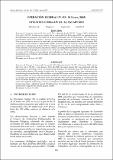Por favor, use este identificador para citar o enlazar este ítem:
https://hdl.handle.net/20.500.12958/3562Registro completo de metadatos
| Campo DC | Valor | Lengua/Idioma |
|---|---|---|
| dc.contributor.author | Bouchon Corrales, Marilú | - |
| dc.contributor.author | Vásquez, Luis | - |
| dc.contributor.author | Segura, Marceliano | - |
| dc.contributor.author | Castillo Valderrama, Ramiro | - |
| dc.date.accessioned | 2021-07-12T21:33:14Z | - |
| dc.date.available | 2021-07-12T21:33:14Z | - |
| dc.date.issued | 2021-06 | - |
| dc.identifier.citation | Inf Inst Mar Perú 48(2), 2021, p. 290-297 | es_ES |
| dc.identifier.issn | 03787702 | - |
| dc.identifier.uri | https://hdl.handle.net/20.500.12958/3562 | - |
| dc.description.abstract | La Operación Eureka LIV se realizó del 23 al 24 de enero 2002 con participación de 28 embarcaciones pesqueras que cubrieron el área comprendida entre 4°S (Máncora) y 14°S (Pisco) hasta las 100 millas náuticas de distancia a la costa. Los resultados indicaron que el ambiente marino frente al Perú se encontraba en proceso de transición de condiciones moderadamente frías en la primavera 2001 a condiciones casi normales a ligeramente cálidas en enero 2002. Las áreas de mayor concentración de anchoveta se presentaron de Supe (6°30’) a Mórrope (11°S) y fueron concordantes con aquellas donde venía operando la flota industrial, tal como se verificó con el Seguimiento Satelital ARGOS. Se comprobó la masiva presencia de ejemplares menores de 12 cm en casi toda el área explorada, estimándose un volumen no menor de 2,3 millones de toneladas de estos individuos, sobre una biomasa total (juveniles + adultos) de alrededor de 7,0 millones de toneladas. Se calculó que estos casi duplicarían su peso hacia el segundo trimestre del 2002. | es_ES |
| dc.description.abstract | ABSTRAC: From January 23 to 24, 2002, Operation Eureka LIV was conducted with the participation of 28 fishing vessels covering the area between 4°S (Máncora) and 14°S (Pisco) up to 100 nautical miles offshore. The results indicated that the marine environment off Peru was in the process of transitioning from moderately cold conditions in spring 2001 to near normal to slightly warmer conditions in January 2002. The areas with the highest concentration of anchoveta were from Supe (6°30’) to Mórrope (11°S) and were consistent with those where the industrial fleet had been operating, as confirmed by the ARGOS Satellite Tracking. We verified the massive presence of specimens smaller than 12 cm in almost the entire area explored, estimating a volume of no less than 2.3 million tons of these individuals, out of total biomass (juveniles + adults) of around 7.0 million tons. We estimated that these individuals would almost double their weight by the second quarter of 2002 | - |
| dc.language.iso | spa | es_ES |
| dc.publisher | Instituto del Mar del Perú | es_ES |
| dc.relation.ispartofseries | Informe Imarpe;48(2), 2021 | - |
| dc.rights | info:eu-repo/semantics/openAccess | es_ES |
| dc.rights.uri | https://creativecommons.org/licenses/by/4.0/ | es_ES |
| dc.source | Instituto del Mar del Perú - IMARPE | es_ES |
| dc.source.uri | Repositorio Digital IMARPE | es_ES |
| dc.subject | Recursos Marinos | es_ES |
| dc.subject | Anchoveta peruana | es_ES |
| dc.subject | Cruceros de investigación | es_ES |
| dc.subject | Eureka | es_ES |
| dc.title | Operación Eureka LIV (23 - 24 enero, 2002) | es_ES |
| dc.title.alternative | Operation Eureka LIV (23 - 24 January 2002) | es_ES |
| dc.type | info:eu-repo/semantics/article | es_ES |
| dc.publisher.country | Perú | es_ES |
| dc.subject.ocde | http://purl.org/pe-repo/ocde/ford#1.06.12 | es_ES |
| Aparece en las colecciones: | Informe vol. 48(2) 2021 | |
Ficheros en este ítem:
| Fichero | Descripción | Tamaño | Formato | |
|---|---|---|---|---|
| Informe 48-2 artículo10.pdf | 4,27 MB | Adobe PDF |  Visualizar/Abrir |
Este ítem está sujeto a una licencia Creative Commons Licencia Creative Commons

